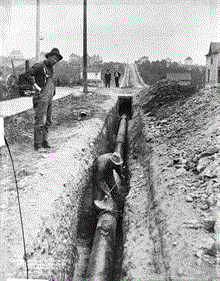
https://www.flickr.com/photos/lecercle/3833274440
Putting a human experience to water infrastructure makes it real.
Our nation’s infrastructure is crumbling and in need of reinvestment—this is the general message I hear over and over these days. Yet figures such as $1 trillion to repair and upgrade our nation’s drinking water infrastructure are difficult to conceptualize—let alone fathom where the money will come from. In fact my eyes just glazed over.
When I hear the word "infrastructure" today, the conversation is usually centered on either the need for funding its repair and replacement, or improving policies for regulating it. The tangible, human relationship to what ‘it’ is can often seem vague, removed from everyday life. Particularly in the world of water delivery, the fact that in North America we have more than 1 million miles of pipes beneath our streets designed to bring drinking water to our homes and businesses is hard to grasp. What does 1 million miles even look like? Well, the circumference of Earth at the equator is about 24,902 miles, so 1 million miles of pipe would wrap around our planet 40 times. That’s a lot of pipe to maintain.
And yet, water infrastructure is a very real experience. It’s what supports our ability to bathe, wash dishes, do laundry and enjoy a glass of H2O. I was reminded of this recently while attending WaterCon with fellow water industry professionals in Springfield, Ill. The effort involved in keeping our water infrastructure working was brought home while watching the annual pipe tapping contest. A team of operators race against time to drill into a pressurized, cement-lined, ductile iron pipe and install a functioning water tap for service.
This high-profile, high-energy competition reminded me of the critical job that water operators have keeping our kitchen sinks and showers working. I was in awe at their level of pride and dedication; these are the folks on the front lines working every day to ensure our million miles of pipes continue to deliver water to us. I am proud to work among them.
Encourage your municipalities and utilities to take the survey.
I think we can all agree safeguarding our drinking water infrastructure is important. It’s something to pay attention to and support, and with the “Replacement Era” of water infrastructure upon us, there’s no time like the present. That’s why the Metropolitan Planning Council (MPC) has partnered with the Illinois Environmental Protection Agency and Metropolitan Mayors Caucus to improve access to the State Revolving Fund for water infrastructure investment. We are currently collecting feedback until Friday, April 17, from municipalities, utilities and consultants in order to increase access to these needed infrastructure investment dollars so that communities continue to have safe and reliable drinking water. We are chipping away at that mind-numbing $1 trillion figure one funding opportunity at a time.

https://www.flickr.com/photos/seattlemunicipalarchives/2722914098
Installing our Nation's water pipes—in 1899.
We need to support our local water utilities in making the necessary reinvestments to our water systems—just like our fire and police service, they are providing all of us with critical needs. Infrastructure does not exist by itself. It involves people: the people who build it, operate it, maintain it, finance it and ultimately use it. On the other end of my water faucet is an actual person. Putting a human face to infrastructure helps make it more real, connects us to one another and helps remind us about the importance of it in our everyday lives—all 1 million miles of it.